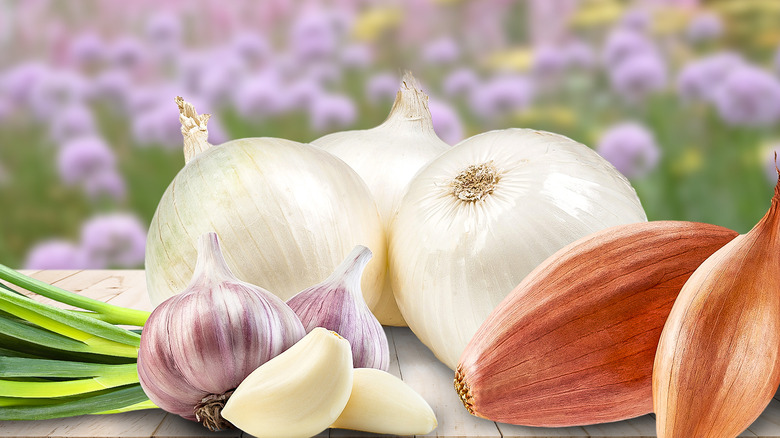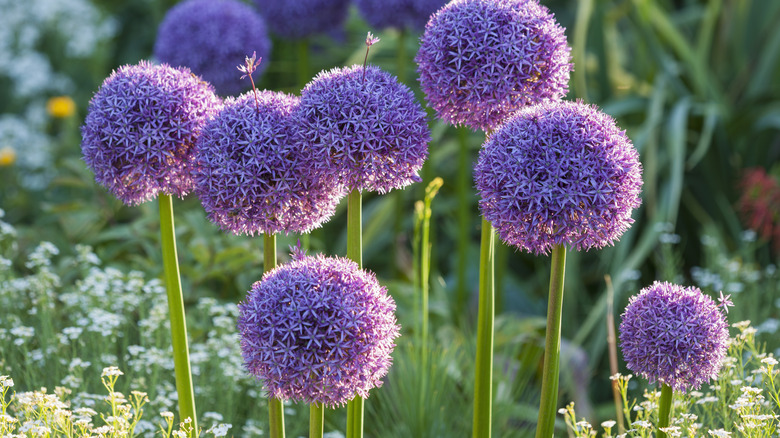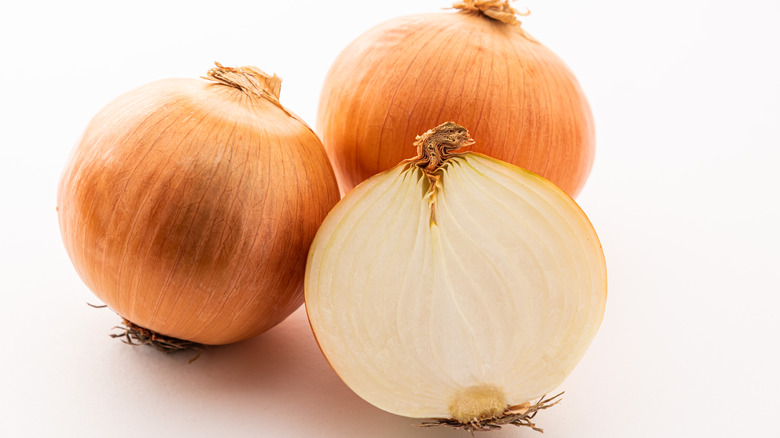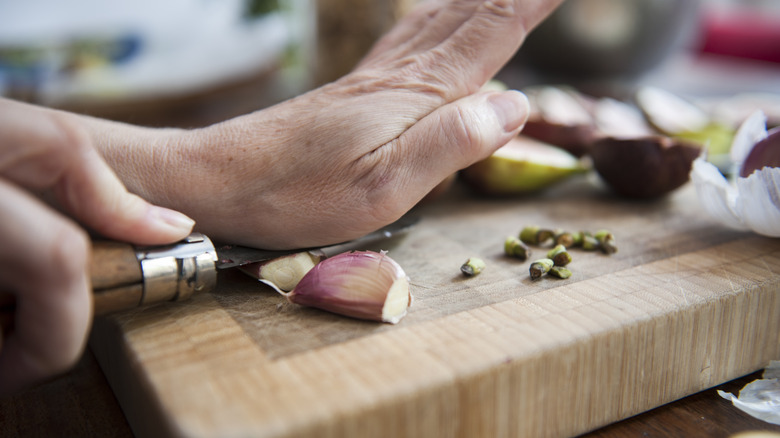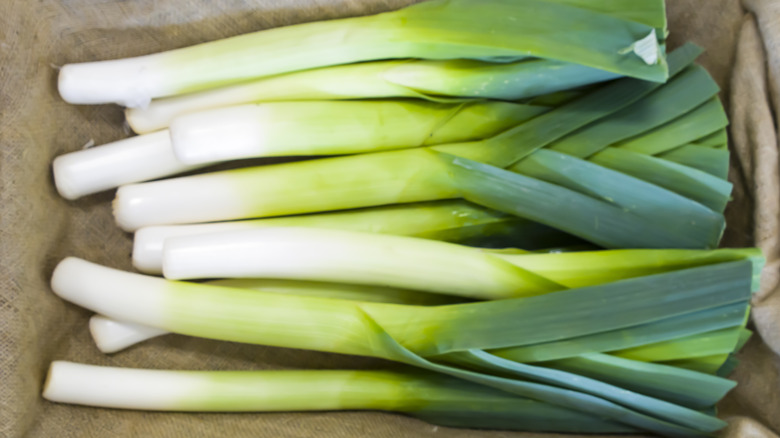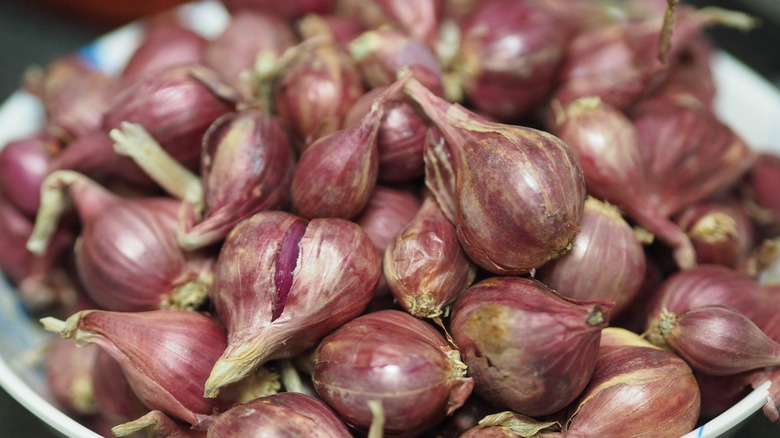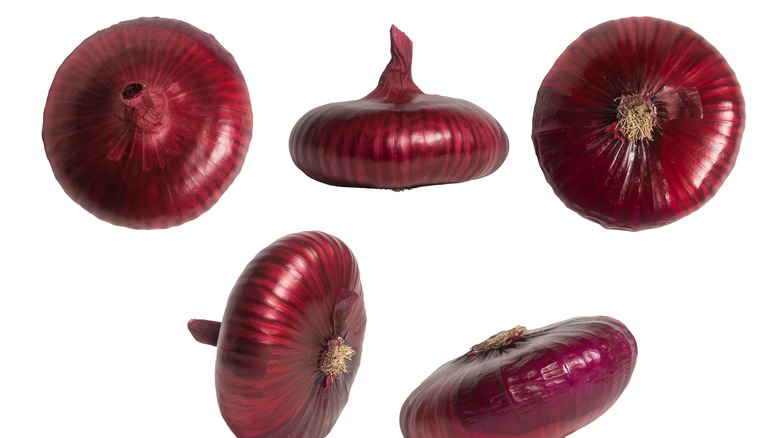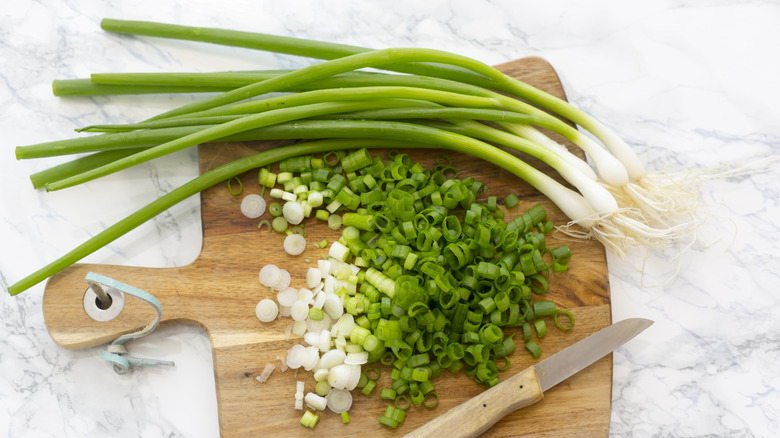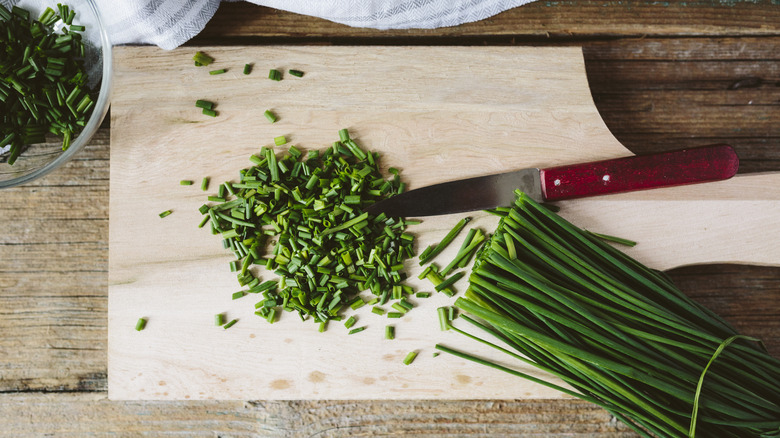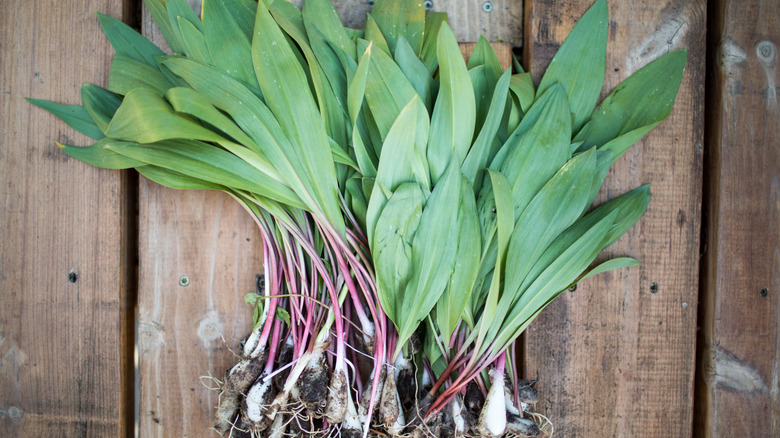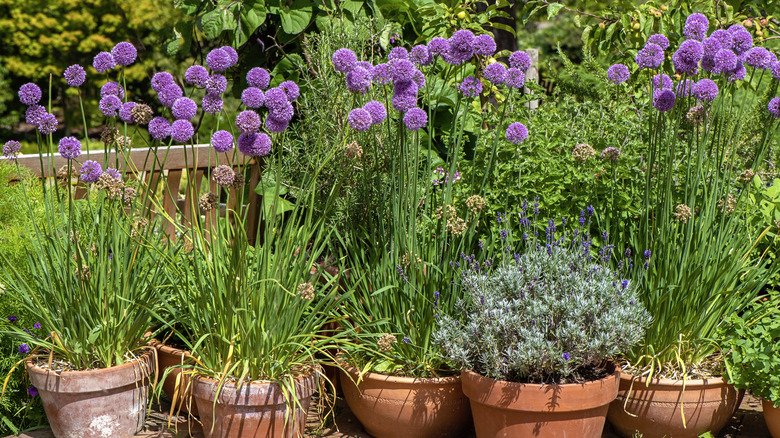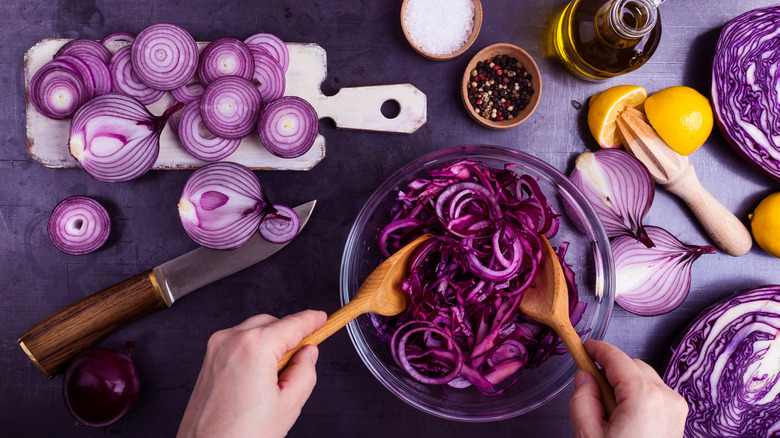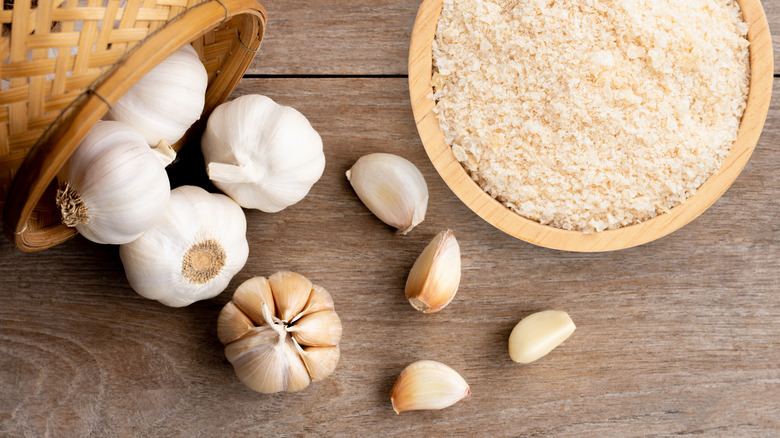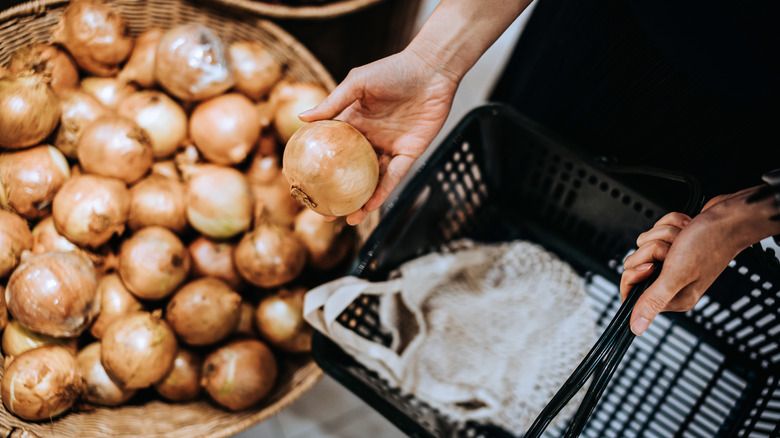8 Alliums To Use In Your Cooking, And What They Do
We may receive a commission on purchases made from links.
What do onions and garlic, scallions and chives, leeks and shallots all have in common? They're all alliums, and they all have a well-deserved role in the home kitchen. Alliums are not only delicious on their own; they make a wonderful flavor base for soups, stews, marinades, dressings, and more. There's a reason alliums have been used for thousands of years, after all.
It's true that almost every home cook uses onions on the regular. Garlic is another star player. But plenty of other alliums, from shallots and leeks to lesser-known varieties make appearances in the kitchen less often. Even if you do use them, do you know how to substitute them properly? Or how to achieve the right flavor for a particular dish through correct preparation and cooking? How about where to find the best wild garlic or how to avoid bitterness in onions?
Never fear — by the end of this article, you will. So make like the ancients, who have cultivated onions for at least 5,000 years, and get more alliums in your diet today.
What is an allium?
The allium family, Alliaceae, is rich in culinary plants. It contains bulb onions (usually known colloquially simply as "onions"), garlic, chives, green onions (scallions), leeks, shallots, ramps, and more. Alliums are a widespread lot, characterized more by their flavors than by the forms in which we use them. It's true that alliums share a common structure, with a rooted bulb or white flesh at the base, long green stalk, and flowers at the head. However, we may use the bulb (as with onions and garlic) or focus more on the stems (as with leeks and chive).
The spicy, pungent flavor of alliums, which is the reason they're prized in cooking, is the result of sulfur-containing compounds that act as a defense mechanism for the plant. That's because when cut or bitten, alliums release molecules from the cells that are then able to mix together, forming volatile compounds that can vaporize and irritate the eyes and other body parts. Many animals and insects do not like this flavor and thus will leave the onion alone. Humans are, of course, an exception — because all alliums get sweeter with cooking, mastery of fire has allowed us to use them liberally in cuisines across the world. And you've got quite a few options to choose from.
Onions
Onions (Allium cepa), or bulb onions, come in three basic varieties: white, yellow, and red. These are large, usually about the size of a baseball, and store very well. Sweet onions are usually lumped in with onions in terms of storage and use, but their sweeter nature and higher water content mean they can spoil faster.
Of course, there's a major downside to onions: They make you cry. Boo! However, there are supposedly several tricks to chopping onions without tearing up. You can chill them, create airflow, cut them near an open flame, or cut them under water. You can also just do as this writer does and purchase a pair of onion goggles, which is the best way to avoid the irritation. Literally foolproof.
To substitute for onions, try other types of onions first: cipollini or pearl, for instance. Shallots also work well and hold their shape the way regular onions do. You can also use leeks, but they're of milder flavor, so you may need to use more of them, depending on your recipe. Note that it's a mistake to store onions in your fridge. They're quite porous, absorbing the humidity that is present in most refrigerators, which will soften them and make them spoil more quickly. Cupboards, cellars, and garages are a better place to keep them.
Garlic
Among the spicier alliums, garlic (Allium sativum) is perhaps the most pungent when raw, tasting downright spicy if you bite into a fresh clove on its own. It has high levels of allicin, a chemical byproduct of other compounds that mix when you cut or mash garlic. While other alliums also contain allicin, it is particularly high in garlic, which is why it's usually the hottest one if you eat it plain.
There are a number of myths when it comes to garlic, such as the fact that it's not all that helpful in detoxing or that you can just stick it in your ear to heal an ear infection. However, it's definitely a superfood and you should get more into your diet wherever possible. Knowing how to cook with garlic can really expand your horizons. Roasting it makes for a sweet spread, while chopping it more roughly can make for better flavor in your final results. It also burns very easily, so you want to make sure to add it at the right stage of cooking, when your other veggies are nearly done.
Because it has such an inimitable flavor, the best substitutes for garlic are other types of garlic. You can save yourself from an out-of-garlic experience by keeping garlic powder, minced dried garlic, or minced garlic in water on hand at all times.
Leeks
Leeks (Allium porrum), like other members of the allium family, go from sharp and spicy to mellow and sweet when cooked, but they take it to extremes. The application of heat makes them almost meltingly soft, so they nearly disappear into soups even without blending. You just have to make sure you remove the tough, dark green outer layers, which don't always cook down that nicely. Leeks work well when pickled, too, because you get a nice crunch of oniony goodness without that eye-watering sting effect that comes with the raw sort.
Shallots and scallions are the best substitutes for leeks because they contain a lot of that oniony flavor. Ditto with other alliums. However, you might be surprised to learn that fennel and celery will also do in a pinch, as they have lots of flavor for making bases and their slices look rather like leeks as well.
Shallots
Though they're a less favored onion cousin, shallots (Allium cepa aggregatum) should absolutely be on the everyday rotation of any home cook. They are easy to find, easy to use, and incredibly yummy. While their general flavor profile is like that of onions, they're sweet and flavorful in a way that your traditional onion simply isn't. They're especially good cooked with other sweet ingredients, such as balsamic vinegar. Shallots also make a nice addition to French onion soup along with classic yellow onions, lending a complexity that can set it apart from regular French onion soup recipes.
To substitute for shallots, use any type of onion: regular, sweet, pearl, or cipollini. These all have the pungency of a shallot and hold their shape well, but also caramelize and blend nicely the same way shallots do. However, the best shallot substitutes according to Julia Child include the white part of green onions and finely chopped white onions that have been boiled briefly.
Cipollini onions
Cipollini onions (which are actually just a type of Allium cepa) are as annoying to peel as they are to spell, but they are nevertheless incredibly delicious. They show up a lot in Italian cooking, their name meaning "little onion" in that language. Small, flattened, and super-sweet, they're great candidates for roasting whole with butter, olive oil, salt, and pepper. They make a wonderful accompaniment to vegetarian bowls and go brilliantly with meat. Again, the best substitutes for cipollini onions are other onions, including onion powder.
Keep in mind that cipollini onions will irritate your eyes the same as regular alliums. You can avoid this by using the same tricks as for typical bulb onions. You might also want to use a separate cutting surface, as onion flavors can often linger in cutting boards, imparting them to foods that very much do not mix. (Sorry kids, today we're having sliced apples à la oignon, and there's nothing any of us can do about it.) The best solution? Buy a set of bamboo cutting boards in different sizes and designate one for cutting them.
Scallions
Bright green and mildly spicy, scallions (Allium fistulosum) are a great candidate for using fresh or cooked. When sliced into thin rounds, they're delicious scattered raw on baked potatoes, soups, and salads. When cooked, they work well in omelets and frittatas. Just be careful not to overcook them, as they wilt, brown, and shrivel quickly. By the way, there is no difference between a scallion and a green onion. Spring onions, however, are different. They are simply unmatured bulb onions.
Chives, ramps, and spring onions make for some of the most convincing scallion substitutes. However, you can also use regular onions and shallots, or you can turn to dried seasonings: freeze-dried spring onions and onion powder both do the trick nicely. When subbing for scallions, check out the recipe to determine the best approach, since the best subs are different for raw versus cooked applications.
Chives
Raise your hand if you love chives! Well, so did Europeans since at least as far back as the Middle Ages, and the Chinese have been big fans for the last 4,000 years. Why? Because they're delicious, obviously. Skinny and green, best used raw and snipped into small pieces, chives (Allium schoenoprasum) are one of the easiest alliums to grow in your yard. In fact, the trick will be not growing them — that's how happy they are in the average kitchen garden. Though they look a bit like scallions and people can get confused, they are not the same. Chives are much skinnier than scallions and grow in bushy clumps rather than upright.
Chives are hard to substitute for, since folks almost always use them fresh and minced on salads, stir-fries, soups, baked potatoes, and more. However, scallions will do nicely if you don't have chives on hand. You can also try spring onions and ramps, finely sliced. While they're stronger than chives, they also give a pretty finishing effect and have great flavor for those who can handle it.
Ramps
Ramps (Allium tricoccum), essentially wild leeks, grow in woodlands and are traditionally collected by individuals rather than cultivated. Both their leaves and the white bulb at their base are edible. They're traditionally available in the spring. If you can't find them near you, you might try a farmers market or a specialty food store, where enthusiastic foragers will bring fresh ones harvested within the last few days. Because they're so delicate, you usually won't find them at the grocery store.
The flavor of ramps is stronger than that of leeks or chives, closer to that of onions and garlic. For this reason, they're best cooked. They are one of the first wild edible plants to pop up in spring. They go well with eggs and potatoes, fried as in bacon fat for breakfast. A lunch-ier option is to pair them with pinto beans and cornbread.
Subbing for ramps is a bit more difficult because they're so unusual. However, if they're not the star of the show, you can use scallions or spring onions, or perhaps even leeks.
Less traditional alliums
There are, of course, less traditional members of the allium family. There are more than 800 species of allium, so it should come as no surprise that there are dozens used around the world, depending on culture and cuisine. Many of these aren't available at traditional American grocery stores, though you'll find more options than you expect if you know where to look.
For instance, you might try elephant garlic (Allium ampeloprasum var. ampeloprasum). While it is in the same family as the rest of the alliums, it's actually more closely related to leek than onion. Chinese onion (Allium chinense), as the name suggests, is popular in Eastern cuisines. It's good pickled, and you will likely find it at your nearest Asian grocery. Then there are garlic scapes, which are actually just a form of garlic. You pick the stems while they still have the curly flower bud on the top, before it blooms into a purple flower. This is a great way for home gardeners to enjoy garlicky flavor but get some green veggies in at the same time.
How to cook alliums
Alliums respond to a variety of cooking methods. First and foremost, you can use them raw on salads or in salsas, or top hot dogs with chopped red onions, which adds a delicious bite. Chives and scallions are also amazing raw. Then there are the cooking options, which range from sauteing and baking to roasting and frying. The approach you choose will depend on the dish, so take your cue from the recipe.
Caramelizing is one of the best ways to make normally pungent onion sweet, mellow, and rich. Note that although it's touted as a popular hack, you actually shouldn't use baking soda to speed up onion caramelization. It's true that it helps to break down the onions sooner, which can reduce the caramelization time from agonizingly long to merely long, but you'll lose the delicious consistency of the onions. Instead, they will become softer, more like relish or jam. That might be good on a sandwich, but won't work as well in a recipe or dish where you want the distinct texture and form of onions.
Which alliums are good dried?
Prepping fresh alliums during the workweek is tough. Time is limited and life gives us enough to cry about anyway. If that's the case, you can always take a shortcut by buying dried products online.
In this case, "dried" refers to alliums that have been fully desiccated and either flaked or powdered, as you would find in packaged onion soup mix or garlic powder. Typically, it is the alliums with more structure, such as garlic and onion, that work well when dried. Leeks and ramps are better fresh, in this writer's opinion. However, if you have a dehydrator, you can always take your hand to them. And, it should be said, you can find pretty much anything online if you really put your mind to it.
Among the best dried products are dried and chopped onion, which rehydrates well and gives an onion-like effect in soups and stews. Minced onion, dried shallot slices, or minced freeze-dried shallots are also good choices. If you're up for a little more experimentation and want to top a salad or stir-fry, try toasted garlic nuggets or crispy fried onions. Yum.
How can you choose the best products at the store?
Choose onions, garlic, and shallots that are firm, unblemished, bright, and have intact skin. Unlike ripe fruit, say, alliums should not have a smell, which would indicate they've been breached. Also, you want ones that are still fresh, not dried out. The best way to determine this is to weigh them against their peers and choose the heaviest ones, indicating more moisture content. (BTW, this also works very well for citrus fruits.)
Fresh allium varieties, such as scallion, should be bright, bruise-free, and strong-smelling. Their white bulb should be bright and firm. Chives, like any herb, should also be bright and unblemished, and the same goes for spring onions, ramps (if you can find them at the store at all), and leeks. Pearl onions are an amazing treat for the holidays, but consider getting them frozen, which saves you about an hour of painstaking work.
You can also grow your own alliums, which is very easy to do. Onions, garlic, and leeks are all quite undemanding, amenable to growth in a variety of soil types, and able to withstand droughts as long as you provide minimal watering after spring planting.
Storing alliums
How you store onions depends on what type they are. The large round bulbs that we consider a classic onion (think your white, yellow, or red varieties) are the easiest to store. Indeed, they're sometimes called "storage onions" for that very reason. Put them in a dry cupboard, pantry, or garage with decent airflow.
Sweet onions, though they look like traditional onions, are liable to go bad faster due to their higher moisture content, so they're better off in the fridge, where humidity isn't a problem for them. It's easy to tell when these types of onions go bad, because their flesh will soften and their peels will discolor. Like sweet onions, shallots do well uncovered in the fridge.
Delicate green onions don't do well for long periods of time in cupboards because they are not a long-term storage veggie. Instead, keep them in a jar on the windowsill with their roots covered in water, or pop a Ziploc bag over the top of the jar and put it in the fridge. They'll last a week at room temp and 2-3 weeks in the fridge. Other forms of onions have their own storage requirements, so look it up before sticking an allium somewhere and hoping for the best.
